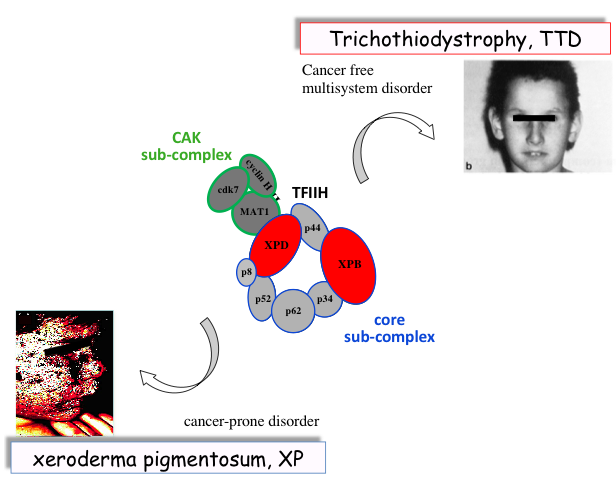Altered molecular pathways implicated in the different skin cancer predisposition of xeroderma pigmentosum and trichothiodystrophy
Xerodema pigmentosum (XP) and the photosensitive form of trichothiodystrophy (PS-TTD) are rare monogenic disorders characterized by distinct clinical features even though they may originate from mutations in the same genes (ERCC2/XPD or ERCC3/XPB). High skin cancer predisposition distinguishes XP whereas brittle sulphur-deficient hair is the defining feature of TTD to which neurological and developmental defects of varying severity, skin alterations, proneness to infections and premature aging are associated. Cutaneous photosensitivity affects both XP and PS-TTD and this is correlated to alterations in nucleotide excision repair (NER), the DNA repair pathway capable of removing structurally unrelated bulky lesions including the UV-induced DNA lesions. ERCC2/XPD and ERCC3/XPB encode distinct subunits of the multiprotein complex TFIIH which plays a key role both in NER and basal transcription. Despite the accumulation of DNA photolesions, PS-TTD patients do not develop skin cancer. Our research has shown that transcriptional alterations affect TTD cells resulting in reduced content of specific collagens in the extracellular matrix (ECM) of the skin dermal layer.
 |
By using RNA-seq and ChIP-seq technologies as well as mass spectrometry, we compare the gene expression and proteomic profile of XP and TTD primary dermal fibroblasts and kerat.inocytes with the aim to identify disease-specific alterations. The comparison allows identifying the molecular mechanisms responsible for the different skin cancer predisposition. |
Nell’ambito di una recente collaborazione con il Prof. Valter Castelvetro e l’Associazione Italiana Xeroderma pigmentosum stiamo testando nuovi composti che permettano di proteggere le cellule epidermiche dei pazienti XP dall’esposizione ai raggi UV. L’analisi è effettuata sulle cellule dei pazienti XP appartenenti a tutti i gruppi di complementazione (da XP-A ad XPG e la forma variante di XP).
A recently established collaboration with Prof. Valter Castelvetro and the Italian Association Xeroderma pigmentosum aims to test the UV-protection activity of novel chemical compounds. This research project intends to provide useful tools directed to ameliorate the daily life of all XP patients.
Collaborations:
- Jean Marc Egly and Emmanuel Compe (IGBMC, Strasbourg, France)
- Luca Bini (Università di Siena, Italy)
- Valter Castelvetro (Università di Pisa, Italy)
- Associazione Italiana Xeroderma pigmentosum (Italy)
